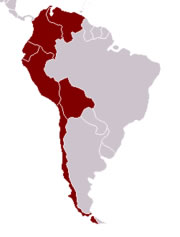 |
| Andean Region |
At the subregional meeting held on 14 and April 15 in Lima, at the headquarters of the General Secretariat of the Andean Community, experts estimated that the growth of the Andean economies in 2011 is somewhere between 3.5% to 7.0% for Developing Countries CAN members, and between 5.5% and 6.5% for Chile.
"This dynamic is presented in a climate of global economic recovery, as the industrialized countries would have a growth of 2.4% this year according to the International Monetary Fund, as well as volatility in international financial markets," they said.
At the subregional level, in 2010 Peru grew 8.8%, followed by Colombia with 4.3%, then Bolivia and Ecuador, with 4.1% and 3.6% respectively, thus marking its recovery after a year of low growth in 2009 as a result of the impacts of international crisis.
"The growth in Peru was associated with expansion of domestic demand (private consumption growth and recovery of private investment), in Colombia due to the recovery of world economy (high prices for raw materials contributed to export growth and the vast resources of FDI) in Bolivia domestic demand recorded a higher incidence of output growth (private consumption behavior and the remarkable rise in public and private investment) and Ecuador was driven by the non-oil sector and public infrastructure investment, "they said.
As regards inflation, the Andean countries have seen an increase in relation to what happened in 2009. Thus, in 2010, Bolivia reported a rate of 7.2%, 3.3% Ecuador, Colombia and Peru about 3.2% to 2.1%, which was due to imported inflation (by increasing international prices of food and imported fuels) and domestic factors (supply shocks such as weather that affected food production), and in the case of Bolivia to a transient capping fuel prices.
As for the Public Sector Fiscal Balance (NFPS), in 2010 the Andean countries had deficits (Colombia had a deficit of 2.9% GDP, Ecuador and Peru 2.1% GDP 0.5% GDP), and Bolivia recorded a surplus of 2.0% of GDP. Peru and Ecuador showed a reduction in their deficits compared to those recorded the previous year, the explanation for this behavior is due to higher tax revenues in both countries and higher oil revenues in the case of Ecuador. Regarding Colombia, the fiscal outcome was affected among other factors, the costs of winter emergency affecting that country.
Public Debt, in 2010 the Andean countries tried to reduce their debt levels compared to last year, so that Ecuador reduced its debt to 23.4% of GDP, Peru to 23.9% of GDP, and Bolivia to 39.8% of GDP , while Colombia had a slight increase reaching 44.1% of GDP.''
This brief description of that part of the continent shows commonalities among these countries, as economic growth is expected, high inflation and fiscal deficits that persist, but the interesting thing to note is how they are growing these economies, ie have to see what factors are driving the somatostatin.
For example, it is more advantageous to have a sustainable and dynamic growth explained by the high domestic demand and private investment, which increased public investment, without detracting from the different paths they have followed the Latin American governments, particularly public investment is well regarded (in my opinion) in times of crisis, and thus be able to make countercyclical economic policies, such as those carried out Chile, which has a reserve fund that generates economic boom periods, to cover the periods crisis, and so continue with rates of growth for GDP.
Although the international market can help the region through the purchase of raw materials latos international prices, are these nations that should increase savings and investment to create conditions to develop.
It should take advantage of cycles of prosperity that economic growth is sustainable over time, this requires the public-private partnerships to invest in infrastructure, education and technology.
Source: comunidadandina.org
Signature: frme
No hay comentarios:
Publicar un comentario